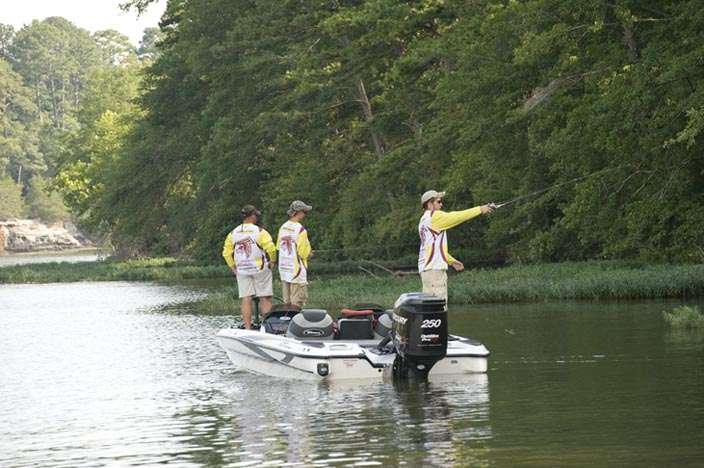
SPRING
Spring is prime time for bass fishing in every Arkansas lake. Elite Series pro Kevin Short of Mayflower, Ark., winner of five Bassmaster tournaments, loves to fish 45,000-acre Bull Shoals just before the bass spawn in mid-April. This bodes well for the Bassmaster Elite Series tournament that happens here April 19-22, 2012.
“Bull Shoals is the best pattern fishing lake in Arkansas because it has hundreds of miles of creek arms and coves,” Short says.
Short first determines which cover holds the bass, say, chunk rock. Then he spends the rest of the day running from one creek to the next catching bass from the same type of cover.
Short typically finds springtime bass at Bull Shoals 5 to 15 feet deep where the bottom quickly rises from the depths to a shallow flat.
A Storm Wiggle Wart in crawdad is the “gold standard” at Bull Shoals, Short claims. He also does well with suspending jerkbaits and a 3/16-ounce Jewel Pro Spider Jig dressed with a Zoom Speed Craw.
“It’s possible to catch a largemouth, smallmouth and a spotted bass on consecutive casts at Bull Shoals,” Short says.
SUMMER
The clear water in many Arkansas lakes pushes bass deep in the summertime. Savvy anglers go down after them with light lines, shaky head worms, drop shot rigs and other finesse baits.
If you prefer casting to shallow bass, head to the Arkansas River, which is what Elite Series pro Scott Rook does. A committed river rat, Rook fishes the Arkansas from Ft. Smith south to Dumas. A large, navigable river with barge traffic, the Arkansas is divided by a series of dams.
“All the pools are good,” Rook says. “I fish the main river in the summertime. There’s usually some current there that keeps the bass fairly shallow.”
Rook targets riprap banks and dikes that break the current for largemouth and spotted bass. His go-to baits are jigs and shallow-running square-billed crankbaits. Rook also tempts bites from Arkansas River bass with spinnerbaits, buzzbaits and soft plastic lures.
The bass fishing has been especially good on Pool 2 of the Arkansas River, notes Kevin Hopkins, an assistant black bass biologist in the state. This is the southernmost pool near the city of Dumas.
FALL
In response to fall’s cooling water, bass move up from their deep winter haunts and go on a pre-winter feeding binge. You can enjoy fast action with bass on virtually any Arkansas lake and be treated to woodlands washed in brilliant autumn hues.
Eight-time Bassmaster Classic qualifier Stephen Browning dotes on 13,400-acre DeGray Lake, near his hometown of Hot Springs. In autumn, he abandons the lower portion of the lake that he fishes in the summertime and heads to the upper lake where it necks down and flows past steep bluff walls.
“DeGray becomes fisherman friendly in the fall because the bass are only 6 to 8 feet deep and you can see the cover you’re casting to,” Browning says.
Windfalls and rock outcroppings are key spots on bluff walls. Browning works such places over with a football jig dressed with a plastic craw and the super realistic Livetarget Crawfish Crankbait.
If you like smallmouth bass fishing, fall is also a great time to float the upper Ouachita River.
WINTER
Elite Series pro Mark Davis lives a short cast from Lake Ouachita, and he catches many big largemouth bass there during the winter months. When the water temperature chills to the low to mid-40s, one of his most consistent lures is a 3/4-ounce black and blue jig dressed with a Strike King KVD Chunk. Davis works the jig slowly through the outside edges of submerged hydrilla 15 to 22 feet deep.
“Winter bass don’t want a lot of action,” Davis says. “Drag the jig slowly out of the grass, shake it and let it fall. They bite when the jig comes out of the hydrilla.” Davis also dupes Ouachita’s winter bass by twitching a suspending jerkbait in a shad color along bluff walls. Some of Ouachita’s shad die when the water temperature drops, and the jerkbait looks and acts like a distressed shad.
Davis’ jerkbait cadence consists of jerking the lure three times and letting it pause for 4 to 6 seconds. Then he gives it a slight twitch and lets it pause again. The bass strike when the jerkbait suspends during a pause.

